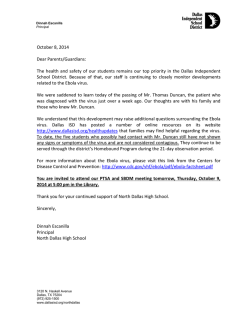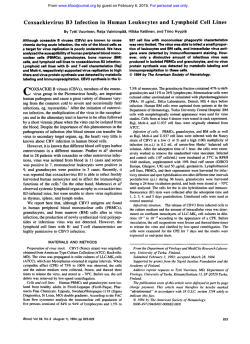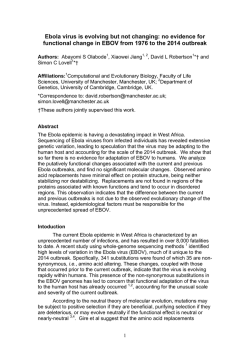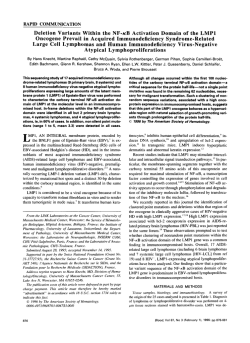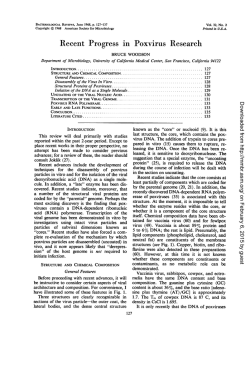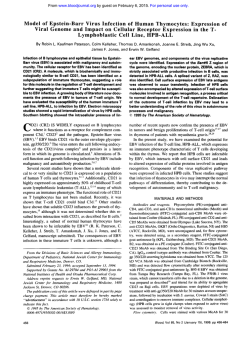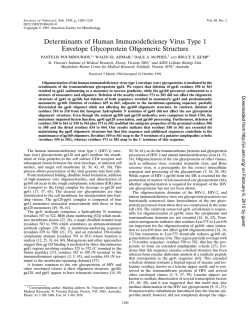
Viruses affecting some bulb and corm flower crops
M. Navalinskienë, M. Samuitienë Viruses affecting some bulb and corm flower crops M. Navalinskienë, M. Samuitienë Plant Virus Laboratory, Institute of Botany, Þaliøjø eþerø 49, LT-2021, Vilnius, Lithuania Eleven viruses were isolated and identified from bulb and corm flower crops widely grown in Lithuania. Viruses were identified by test-plant and electron microscopy methods. Cucumber mosaic cucumovirus (CMV) was identified in Crocus L., Lilium L., Muscari Mill., Narcissus L., Hyacinthus mosaic potyvirus (HyaMV) in Hyacinthus L., Iris mild mosaic potyvirus (IMMV) in Crocus L., Lily mottle potyvirus (LMoV) and Lily symptomless carlavirus (LSV) in Lilium L., Muscari mosaic potyvirus (MMV) in Muscari Mill., Narcissus mosaic potexvirus (NMV) and Narcissus yellow stripe potyvirus (NYSV) in Narcissus L., Tobacco rattle tobravirus (TRV) in Crocus L., Lilium L., Muscari Mill., Narcissus L., Tomato ringspot nepovirus (ToRSV) in Lilium L., Narcissus L., Tomato spotted wilt tospovirus (TSWV) in Lilium L. Symptoms on naturally infected plants have been described and virus particle morphology established. The MMV was purified and the antigene prepared. Key words: bulb flowers, corm flowers, viral diseases, virus identification Bulb and corm flowers as popular verdure plants, cut flowers, commercial crops have been grown in Lithuania for many years. Most prevalent bulb crops are Tulipa L., Lilium L. (Liliaceae Juss.), Narcissus L. (Amaryllidaceae J. St.-Hil.), Hyacinthus L., Muscari Mill. (Hyacinthaceae Batsch ex Borkh.), Crocus L., Gladiolus L. (Iridaceae Juss.). Data on viruses affecting very important bulb crops Tulipa L. and Gladiolus L. have been presented in reports [1, 2]. Ornamental plants suffer considerable losses due to virus infection. Virus diseases reduce the aesthetic quality and marketability of ornamental plants. Viruses survive in infected bulbs and corms and spread due to vegetative propagation by them, are transmitted by vectors. datus L., A. paniculatus L., Atriplex hortensis L., Celosia argentea f. cristata (L.) Kuntze, Chenopodium amaranticolor Coste et Reyn, C. ambrosioides L., C. murale L., C. quinoa Willd., C. urbicum L., Cucumis sativus L. Datura stramonium L., Gomphrena globosa L., Lycopersicon esculentum Mill., Nicandra physalodes (L.) Gaertn., Nicotiana debneyi Domin., Nicotiana glutinosa L., N. tabacum L. Samsun, White Burley, Xanthi, N. rustica L., Petunia hybrida Vilm., Phaseolus vulgaris L., Baltija, Prince, Tetragonia expansa Murr., Trifolium incarnatum L. The inoculum for mechanical inoculation was prepared by homogenizing infected leaves with 0.1 M phosphate buffer (pH 7.0), containing 0.2% 2-mercaptoethanol or 0.01 M sodium diethyldithiocarbamate, 0.1% thioglycolic acid. MMV purification was carried out according to a selected method [5]. MATERIALS AND METHODS RESULTS AND DISCUSION Material for investigation was collected in different floriculture farms and private flower collections in Lithuania. Samples were collected from flowers showing visual virus symptoms. The experimental work was carried out at the greenhouse and Plant Virus Laboratory of the Institute of Botany. Virus has been identified by electron microscopy negative staining technique [3, 4] and test-plant method. The following test-plants were inoculated: Amaranthus cau- A many-year investigation of virus diseases of ornamental plants revealed that bulb and corm flowers are affected by a great number of viruses. Eleven viruses were isolated and identified in those most popular. Cucumber mosaic cucumovirus (CMV) was identified in Crocus L., Lilium L., Muscari Mill., Narcissus L. Symptoms consist in retarted growth, various mosaics, streaking, spotting, distortion of leaves. INTRODUCTION ISSN 13920146. B i o l o g i j a . 2001. Nr. 4 " Viruses affecting some bulb and corm flower crops CMV was identified by mechanical sap inoculation of test-plants (Table 1). Electron microscopy investigation of negatively stained preparations from leaves of naturally infected plants and inoculated testplants revealed isometric particles about 30 nm in diameter. CMV infection in crocus, narcissus was confirmed serologically. Table. Test-plant reaction to inoculation of viruses Test-plant Amaranthus caudatus A. paniculatus Atriplex hortensis Chenopodium amaranticolor C. quinoa Celosia argentea f. cristata Cucumis sativus Gomphrena globosa Nicandra physalodes Nicotiana glutinosa N. rustica N. tabacum Petunia hybrida Phaseolus vulgaris Pisum sativum Tetragonia expansa Trifolium incarnatum CMV L L L L; L L; S L; S L; L TRV L L L S S S S L L L L L L TRSV L; L; L; L; L; L; L; L; S S S S S S S S L L L; S L; S L; S Abbreviations: L local reaction, S systemic reaction. Hyacinthus mosaic potyvirus (HyaMV) infects hyacinths. Infected plants show mottle mainly on the basal parts of leaves which range colour from light green to bright yellow. The mottle is stripe-like. Virus was not transmitted to test-plants by mechanical sap inoculation. Slight flexuous filamentous particles of normal length (740750 nm) were detected by electron microscopy. This particle morphology of HyaMV has been reported in literature [6]. Iris mild mosic potyvirus (IMMV) was identified in crocus. Leaves of infected plants are narrowed, twisted, with light greenish, sometimes necrotic spots and streaks. Petals are crinkled and wavy with a colour-breaking pattern. From a range of inoculated test-plants only Chenopodium quinoa developed local lesions. Electron microscopy revealed slight flexuous filamentous particles of normal length (750 nm) specific for potyviruses. Lily mottle potyvirus (LMV) was identified in some lily cultivars. Leaves of naturally infected plants show yellowish green mottle mosaic, can be twisted and narrowed. Flowers of some cultivars are malformed and may show a breaking pattern. The symptoms are intensified when plants are infected also with LSV. When plants become infected shortly after leaf emergence extreme symptoms such as yellowing and browning of leaves and veins may occur in some cultivars. Viral infection was successfully transmitted by mechanical sap inoculation to C. quinoa and Tetragonia expansa, inducing local reaction. Slight flexuous filamentous particles of normal length (750 770 nm) were detected by electron-microscopy investigation. Lily symptomless carlavirus (LSV) was identified in lily. Many cultivars remain symptomless when infected with LSV. Leaves may show veinclearing or light stripes between the veins. NMV Plants often show reduced growth, smaller flowers, have a pronounced lower bulb yield and shorter vase life as cut flowers. When LSV are coinfected with CMV, leaves show L grey or brown necrotic spots. Flowers are L distorted. LSV was not transmitted to testplants, but was detected by electron microsL copy. Particles were 640650 nm in length as L; S have been reported in literature [7]. Muscari mosaic potyvirus (MMV) was identified in Muscari armeniacum Baker (yellowish green spots and streaks on leaves, in the middle turning to necrosis, leaf narrowing, deformation); M. botryoides (L.) Mill. L (leaves are distorted, narrowed with light greL en dots, tip yellowing); M. pallas (twisted S small leaves with yellowish green striping), M. tubergenianum Hook. (light green stripes extending from the basal parts of leaves, leaf distortion). Virus was identified by test-plant inoculation. Chenopodium murale, C. quinoa and Tetragonia expansa reacted expressing chlorotic local lesions. Flexuous filamentous particles with a normal length of 710 nm were revealed by electron microscopy. Purification of MMV was carried out from frozen C. quinoa leaves. Purified MMV preparation had Amax at 260 nm, Amin at 240 nm, the A260/ A280 ratio being 1.2. The yield of purified virus was 33 mg from 1 kg of plant tissue. Narcissus mosaic potexvirus (NMV) was identified in narcissus. The plants showed retarted growth, leaves were narrowed with mild mosaic symptoms. NMV frequently occurs in complexes with other viruses in more severely affected plants. Virus was identified by test-plant inoculation. Symptoms appeared on C. amaranticolor, C. quinoa, Pisum sativum, Trifolium incarnatum, G. globosa, T. expansa. Electron microscopy revealed filamentous particles about 550 nm long, as has been recorded in the literature [8]. Narcissus yellow stripe potyvirus (NYSV) was identified in narcissus. Infected plants are stunted and have distorted leaves with chlorotic streaks, particularly in their upper parts; often also flowers are broken. Leaf symptoms appear early in the season, soon after leaf emergence. Virus was transmitted by " M. Navalinskienë, M. Samuitienë sap inoculation only to Tetragonia expansa which showed local chlorotic lesions 14 days after inoculation. Electron microscopy revealed flexuous filamentous particles 750 nm long. Such a morphology of NYMV particles has been reported in literature [9]. Tobacco rattle tobravirus (TRV) was identified in crocus, hyacinthus, lilies, muscari, narcissus. Leaves of infected crocus develop light yellow brown necrotic oval spots and ringspots. Flowers are smaller than normal, with a colour-breaking pattern. Leaves of infected hyacinths show light green to yellow stripes and spots. These symptoms may turn to brown or grey necrotic stripes later in the season. Flowers are small, misshapen. Necrosis typical of this virus becomes visible on the bulb scales. Leaves of affected lilies are chlorotic and distorted, with necrotic dots. Plant growth is retarted. Affected muscari develop a light green yellowish mosaic which consists of elongate spots and streaks. Plants are stunted. Bulbs have brown pressed spots. Infected narcissus plants are stunted. Leaves are yellow and distorted by necrosis. TRV was identified by test-plant reaction (Table 1) and from the morphology of particles. This virus has tubular particles of two lenghts, 190 and 55115 nm. Tomato ringspot nepovirus (ToRSV) was identified in lilies, narcissus. Lilies have distorted leaves with chlorotic spots and streaks. Light green mosaic, chlorotic spots and streaks develop on leaves of affected narcisssus. Later in the season chlorotic lesions turn to necrotic and cause leaf distortion. ToRSV was identified by test-plant reaction (Table) and electron microscopy. Electron microscopy revealed isometric particles 28 nm in diameter. Tomato spotted wilt tospovirus (TSWV) was identified in lilies. Plants are stunted, leaves distorted with chlorotic and necrotic spots. Tops of severely affected plants are brown. Virus was identified by electron microscopy and using literature data [7, 10]. Isometric irregular particles 85110 nm in diameter were detected in leaves of naturally infected plants. A great number of the viruses identified (HyaMV, IMMV, LMV, LSV, MMV, NMV and NYSV) are " specific to host-plant and infect a restricted hostplant range. CMV was widespread earlier in many ornamental plants in Lithuania, but now the situation has changed and infection of other viruses such as ToRSV, TSWV occur more frequently than CMV. Mixed viral infections are common in these flowers. References 1. Navalinskienë M., Samuitienë M., logija 1994; 4: 448. 2. Navalinskienë M, Samuitienë M. 3. Brandes J. Nachr dt Pfl Schutzd, 34 (1): 10310. 4. Brenner S, Horne RW. Biochim 9: 1512. Jackevièienë E. BioBiologija (in press). Braunschweig 1959; Biophys Acta 1959; 5. Íîâèêîâ ÂÊ, Àòàáåêîâ ÈÃ, Àãóð ÌÎ è äð. Ñåëüñêîõîç áèîë 1982; 17 (5): 70611. 6. Derks AFLM, Vink-Van den Abeele JL. Acta Hortic 1980a; 109: 495502. 7. Loebenstein G, Lawson RH, Brunt AA (eds.). Virus and Virus-like Diseases of Bulb and Flower Crops. ChichesterNew York, 1995. 8. Brunt AA. Ann Appl Biol 1966; 58: 1323. 9. Brunt AA. CMI/AAB Descriptions of Plant Viruses 1971; 76: 14. 10. Llamas-Llamas ME, Zavaleta-Mejia E, Gonzalez- Hernandez VA et al. 1998; 47 (3): 3417. M. Navalinskienë, M. Samuitienë VIRUSAI, PAÞEIDÞIANTYS SVOGÛNINES IR GUMBASVOGÛNINES GËLES Santrauka Ið svogûniniø ir gumbasvogûniniø gëliø iðskirta ir identifikuota 11 virusø. Jie identifikuoti augalø-indikatoriø ir elektroninës mikroskopijos metodais. CMV identifikuotas krokuose, lelijose, þydrëse, narcizuose, HyaMV hiacintuose, IMMV krokuose, LMoV ir LSV lelijose, MMV þydrëse, NMV ir NYSV narcizuose, TRV krokuose, hiacintuose, lelijose, þydrëse, narcizuose, ToRSV lelijose, narcizuose, TSWV lelijose. Apraðyti natûraliai uþsikrëtusiø augalø simptomai ir nustatyta virusiniø daleliø morfologija. Iðgrynintas MMV ir paruoðtas antigenas.
© Copyright 2026
